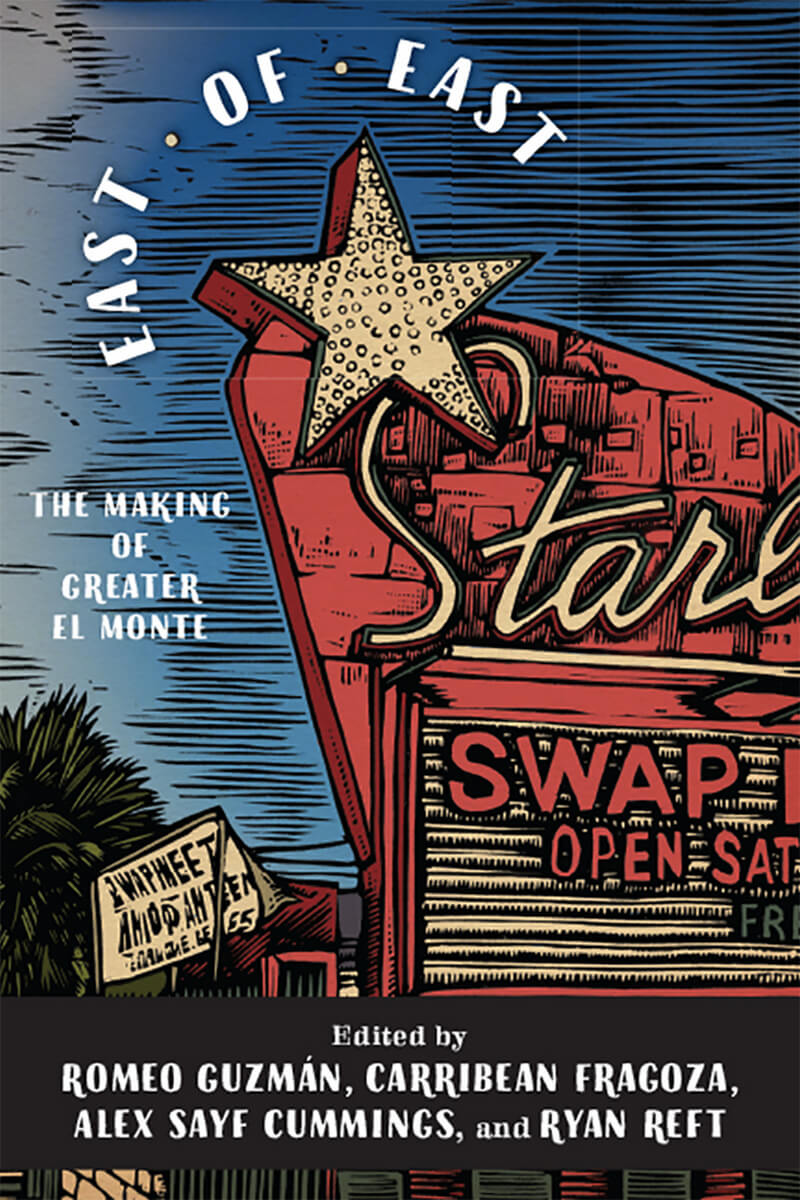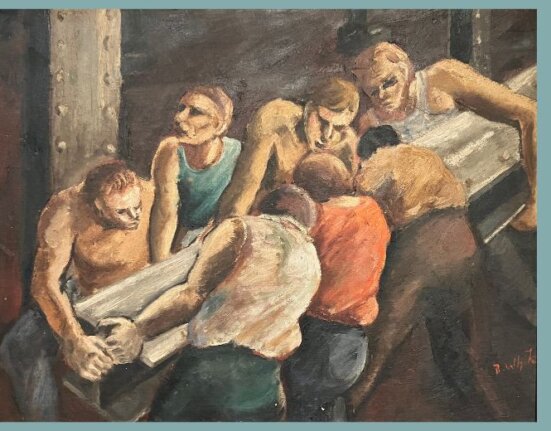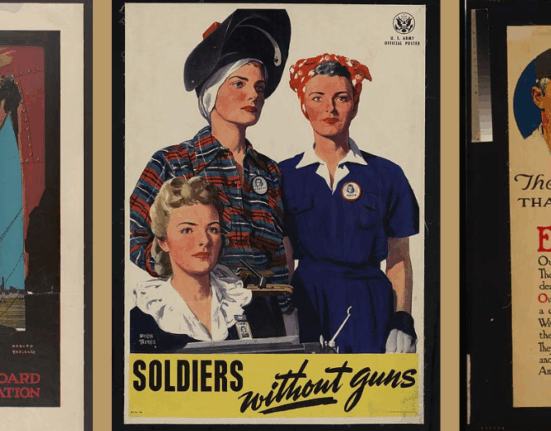A People’s History of Life and Labor in the San Gabriel Valley: An Interview with authors and editors of East of East: The Making of Greater El Monte (Rutgers, 2020).
We’re here to talk about East of East: The Making of Greater El Monte, a collection of 31 essays edited by Romeo Guzmán, Carribean Fragoza, Alex Sayf Cummings, and Ryan Reft. The book was released in late February in Rutgers University Press’s Latinidad series (edited by longtime LAWCHA stalwart and former board member Matt Garcia), and like all books released in 2020, its editors and authors are promoting it remotely.
Joining us today are editor Alex Sayf Cummings and LAWCHA member and author Adam Goodman, both of whom, it should be noted, contributed to this project while launching their own books this year, Brain Magnet: Research Triangle Park and the Idea of the Idea Economy and The Deportation Machine: America’s Long History of Expelling Immigrants, respectively.
For my own part, I’m a contributor to this collection, a LAWCHA member, and a labor historian. I’ve been teaching pieces from this project since they first appeared on Tropics of Meta years ago, and I’m convinced LaborOnline readers will want to know about this book. East of East may not be explicitly marketed as labor history, but these essays offer some of the best of what our field aspires to do. East of East demolishes top-down, elite-driven historical narratives, foregrounds the stories and struggles of working people, and amplifies the voices of working-class writers and scholars. If I haven’t convinced you, let Alex and Adam do so.

Nick Juravich: Let’s start simple: what do we want labor historians to know about this book?
Adam Goodman: East of East’s essays center on the everyday lives and experiences of working people from diverse backgrounds who shaped the histories of El Monte and the San Gabriel Valley. The book addresses themes of great interest to LAWCHA members—including race and migration, labor activism and organizing—and forces readers to reconsider the mainstream, white pioneer narrative of the making of California and the West.
Building on that first question, this is also a book that could definitely be characterized as “people’s history,” a term made famous by Howard Zinn but now applied to collaborative efforts. Wendy Cheng, one of the book’s contributors and early champions, worked on one example, the People’s Guide to Los Angeles; Tropics of Meta, which Alex co-founded with Ryan and now co-edits with Romeo, is another (the blog’s tagline is “historiography for the masses”). How does the people’s history tradition inform this book, or help potential readers understand what they’ll find inside?
Alex Cummings: I think academic historians have often been pretty dismissive of Zinn’s work, which is admittedly somewhat polemical in nature. Yet A People’s History of the United States undoubtedly reached and influenced more readers than the vast majority of other historians’ work, and not just in the dumb-as-shit Bill O’Reilly best-selling Killing Millard Fillmore type of way. Zinn awakened a critical awareness of history that led many young people to want to be activists and scholars. We believe strongly that historical storytelling and interpretation can be democratic, inclusive, empowering, and engaging without losing its scholarly integrity, which is why many of us involved in East of East focus on public history in our publishing and teaching. We definitely looked to the wonderful People’s Guide to Los Angeles that Wendy, Laura Barraclough, and Laura Pulido put together as a model. I often thought of it as faintly echoing the WPA guides of the 1930s, and the many other efforts of the Depression Era to tell the stories of people below the radar and at the margins — workers, farmers, former slaves, the unemployed — and, through oral history and song, to tell their own stories. We hope that East of East can continue in this tradition of people’s history, while also joining with all the multitude of projects that are now using new media to document history and empower diverse communities.
Nick: To make one more people’s history connection, just as one of the most enduring legacies of Zinn’s work is the Zinn Education Project, the entire East of East project has built connections with the public schools in El Monte and South El Monte since the beginning. Local educators feature as both the subjects and authors of essays in this book, and the South El Monte Arts Posse, the collective from which the project sprang, has hosted several workshops and events with local teachers and students over the past decade. Even before the book was released, this material was being used in K-12 classrooms. This focus is one of the reasons the essays in this book work so well in the classroom. On to the next question!
One of the central themes of East of East, of course, is migration, which can’t meaningfully be disentangled from work and labor. Both Adam and Alex write directly on this in East of East. What does the history of Greater El Monte help us understand about the history (and present and future) of migration?
Adam: Greater El Monte is a fascinating place, where people from across the country and around the world have long converged. The area lends itself to historical research on migration, not to mention race and labor relations. My essay, for example, explores the history of a shoe factory and the interconnected lives of two people: Arthur Sbicca, an Italian American man whose family owned the company, and Guadalupe González, a Mexican woman who worked there in the late 1970s. (Today, the old shoe factory is a Vietnamese grocery store; an interesting side note that speaks to the many migrations that have shaped the region, something that Alex also discusses in her essay.) Tracing these two stories allows me to connect the histories of European immigration at the turn of the twentieth century and Mexican migration during the past half century. It shows how globalization, racism, and a bifurcated economy limited Mexican migrants’ opportunities and constrained their upward mobility. The piece also points to the uncomfortable fact that some immigrants’ American dreams have been built on the backs of other immigrants.
Alex: Indeed, Adam’s essay does a terrific job of showing how multiple waves of migration — often treated as distinct and separate, chronologically, demographically, geographically — overlapped and intercut each other. I think this book offers a valuable perspective by showing how the San Gabriel Valley was an arena of migration and conquest, displacement and refuge over centuries, not just at the critical moments that many histories have focused on (say, the Bracero-era or the post-Vietnam War influx of migration from Southeast Asia). I think East of East is also a corrective to the still-persistent tendency, especially in popular media and mainstream education, to view the history of immigration to the US from an East Coast/European perspective, and secondarily from a West Coast/US-Mexico border perspective. Scholars have broken ground by telling the stories of Asians and Asian-Americans in the West (see Wendy Cheng and Charlotte Brooks’s work, for just two examples), but we want to continue this work by bringing an even finer grained picture that embraces a fuller range of communities. My piece, for instance, centers primarily on the stories of Vietnamese, Thai and other Southeast Asian migrants, who navigated really unique paths of work, foodways, and identity in a predominantly Latinx cultural environment — paths that were also distinct and specific in the context of Asian communities in the SGV that were largely Chinese-American. As Christine Tran, a Vietnamese-American educator and food policy analyst who grew up in El Monte, told me, “I remember somebody calling me ‘Chinese sushi’ [in school] and I had no idea what sushi was.”
Adam has just written a new book on exactly this, and his essay in East of East is drawn from research he did for The Deportation Machine. For those who haven’t read your essay, how are these two projects connected? For that matter, how did you first encounter the stories from El Monte that appear in both books?
Adam: I first came across the shoe factory while conducting research for The Deportation Machine. The Immigration and Naturalization Service (the precursor to the Department of Homeland Security) carried out nearly twenty raids on this single factory, apprehending more than 1,000 workers between the late 1960s and the late 1970s. A chapter of my book reconstructs one of those raids and its consequential aftermath, during which a group of undocumented workers, labor organizers, activists, and lawyers fought the deportation machine—and won. Getting access to the materials that allowed me to piece together this story proved challenging. But I had the good fortune of spending a year in Los Angeles, where I pored over federal district court records and case files stored in a legal aid organization’s storage unit next to the 110 freeway. In the end, I found more than enough information—too much, really—and knew most of it wouldn’t make it into the book, so I started to think about other possibilities. Also, Romeo Guzmán and Carribean Fragoza, two of the editors for East of East editors and the co-directors of the South El Monte Arts Posse, invited me to present my research about the shoe workers’ resistance. I jumped at the offer and gave a talk one weekend at the El Monte Public Library. After, a woman came up to me and said that she had worked at the factory when the raid happened. I got goosebumps as she told me, and we later sat down for an interview. That was Guadalupe González, whose story I recount in my essay.
Nick: I have to chime in here because I had a very similar experience, and I think it speaks to the whole ethos of the project. I wrote the first version of my essay, “City of Achievement,” having never been to South El Monte; I used materials the East of East team had unearthed and supplemented them with research in digitized sources from afar. As soon as it went up on Tropics and KCET, we got replies from local residents who knew more and wanted to share. Some of their comments helped inspire whole separate essays (I think of the person who wrote saying “you didn’t mention the 60 freeway!” and how lucky it was that Ryan Reft was already writing on freeways across Southern California). For my own part, when I went out to spend two weeks doing research, oral histories, classroom workshops, and events with the East of East project in 2015, I interviewed two of the folks who’d reached out, Dana Law and Richard Hernandez. The stories they shared helped improve my revised essay (which appears in the book), and the full oral histories are hosted in the East of East digital archive, where we also posted some clips and transcriptions for classroom use by K-12 teachers.
While we’re on the topic of new books, Alex, the history you illuminate in Brain Magnet takes place on the other side of the country in North Carolina’s Research Triangle Park, but at a conceptual level, it seems to me that both of these projects ask questions about the intersection of place and political economy, and how ideas about places and the people who live there — both as they are and as people wish them to be — shape economic development (unevenly and unequally). Am I reaching here, or are there ways that these two projects connect in your mind, too?
Alex: Oh, certainly! At first glance, the San Gabriel Valley and the Research Triangle (the area encompassing Raleigh, Durham, Chapel Hill, and Cary) could not appear to be more different. The Triangle, while diverse relative to the rest of North Carolina and the Southeast, nowhere near approaches the vast and complex ethnic landscape of greater LA. However, I got interested in the story of the Triangle and RTP — a high-tech research park founded in the late 1950s — in part because this project did draw people from all over the United States and the world to work in the park’s laboratories, and neighboring spin-offs and start-ups. RTP was part of the story of North Carolina moving from its historical black-white racial dynamic to a much more varied cultural mix, particularly with the arrival of Asian and Latinx workers since the 1970s. So I was interested in the stories of those individuals and families who migrated to seek opportunity, particularly in tech employment; oral histories provided a rich insight into how people adapted to the cultural milieu of the New South and the Bible Belt, and subsequently transformed it.
One notable difference between the SGV and the Triangle is this: while El Monte and its surrounding communities were shaped, over centuries, by literally millions of different people, communities, economic forces, laws and policies, movements and struggles, in unpredictable ways, the Triangle is very much the result of one highly intentional and specific project. The story I’m telling here is about how a group of elites laid out a plan for a high-tech economy of the future, and the ideology and aspirations of the professional workers who came to build what was, in their minds, a kind of Jetsons-style upper middle-class Sunbelt utopia (with all the unspoken implications of racial and economic inequality and exclusion that come along with that vision). In that way, its historical trajectory might be more akin to Orange County’s than the SGV’s. (And of course the Triangle has its own Orange County!)
One of many things that makes this collection remarkable is the presence of remembrances, personal reflections, and a whole section of “literary cartographies”: pieces of creative nonfiction by writers with personal connections to Greater El Monte. These beautiful essays reflect the fact that East of East emerged from a series of projects that combine history, the arts, place-making, and community organizing, and I think they also make the book more powerful as an intervention in labor/working-class/people’s history. Alex, I’d love to hear about how you thought about these pieces, as editors of both the original series on Tropics of Meta and a book with an academic press.
Alex: We hope that people find even the more traditional historical pieces in the book to be engaging and accessible. But we were also firmly committed to bringing a more literary, immersive vantage point on the history and the landscape examined in the book. We are honestly just really proud of these pieces. You have one of our editors and project founders, Carribean Fragoza, offering a lyrical memory of the built environment along Rush Street, of her life working and traveling as a young woman in South El Monte, where issues of class, cultural difference, and gentrification float subtly into the frame. The novelist Michael Jaime-Becerra gives us “1181 Durfee Avenue,” a kind of prose-poem, which is a window into the subjective dimension of history, the phenomenological and interior experience of childhood and youth culture during the early 1980s.
I like to think that, if a traditional historical or social scientific study of, say, gentrification gives you the analytical bones, these stories are the flesh that can tell you so much more than a purely schematic outline of the skeleton. It is unusual for creative nonfiction to appear in a history book from an academic press, but Rutgers University Press and Matt Garcia were willing to take the gamble with us on this approach, and I think it makes the book both a richer and more informative picture of the past.
Finally, teaching: I’ve used East of East essays in my classes since I first got involved with this project, and I know from talking to both of you that you have, or plan to, as well. How can people use these essays in the classroom and, if you’ve taught them, how have students responded?
Adam: These essays are short, accessible, grounded in rigorous research, and mainly focused on ordinary people; they’re ideal for teaching labor history, social history, public history, or urban history, among other areas. And, together, they offer broad chronological and topical coverage, which allows one to both teach students about change over time and expose them to different types of history and historical writing.
In closing, could you say a bit about the origins of the book — which we once called a “reader” — in the world of history blogging and digital history work?
Alex: The project found its first home at Tropics of Meta, which is a history blog that has always resisted categorization in terms of subfield and focus. This is probably why East of East and ToM were such a good fit. We are anxious not to have this project pigeonholed as only urban history or only ethnic studies or only labor history; it’s not either/or but both/and, maybe. There is a lot of really important labor history in the book, from workers’ movements in the 1930s to the struggles and experiences of the new working class of the twenty-first century, but it’s interwoven with architectural and environmental history, studies of popular culture from punk to Zumba, and people’s journeys through the politics of race, gender, and sexuality. It is a feast where there’s something tasty for everybody, we hope.
East of East: The Making of Greater El Monte, available now from Rutgers University Press.







